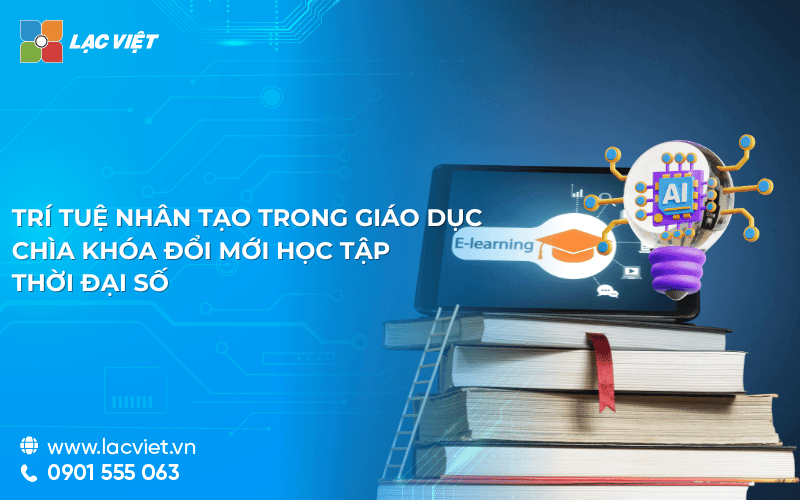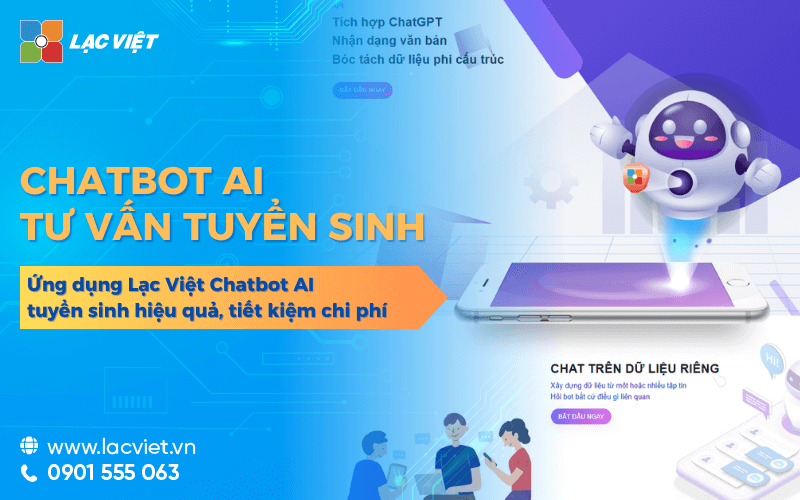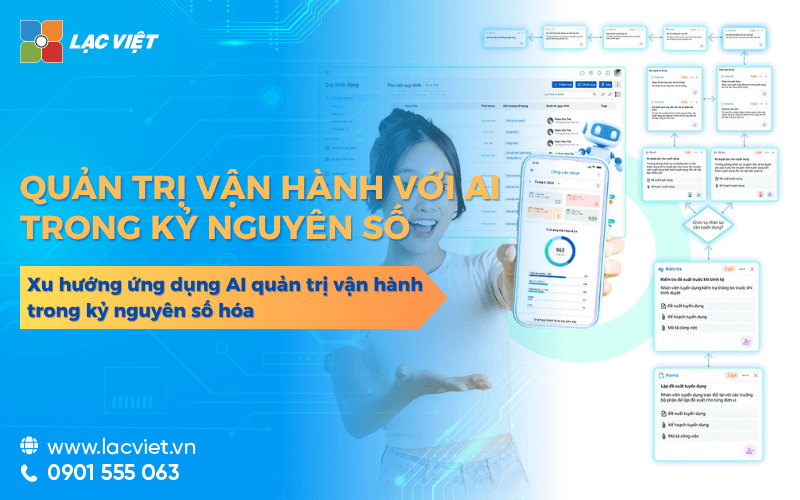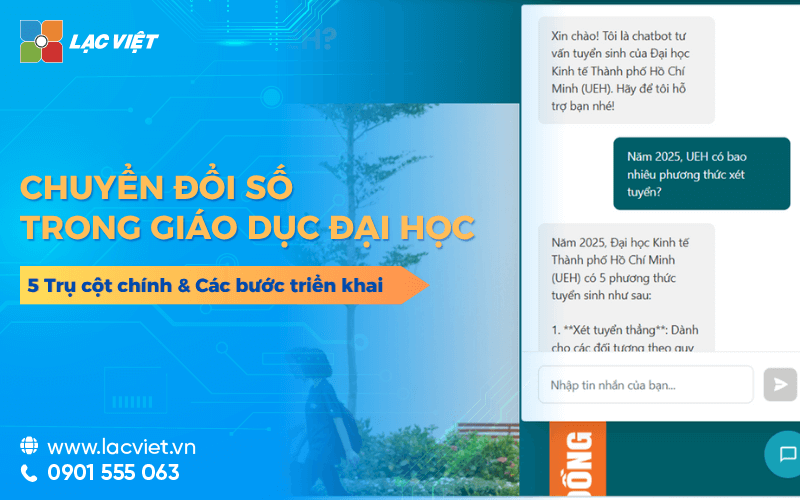In the era of 4.0, digital technology has become a driving force to promote the rapid development of all fields, and education is not an exception. Artificial intelligence (AI) is one of the most important achievements of the technological revolution are opening up the new potential for the education sector. This technology not only as tools but also as strategic solutions that help educational institutions improve the learning experience, and meet the development needs of the younger generation.
This article Lac Viet Computing will provide an overview to details about artificial intelligence in education, outstanding benefits, the practical application, as well as guidance for effective implementation to support educational institutions approach this technology in an easy way.
The same theme:
- Application AI in medical bring the benefits?
- 8 Applications AI in finance current highlights
1. Artificial intelligence in education, what is?
Artificial intelligence (AI) in education is the application AI technology to improve the learning experience, optimize the teaching and education management. AI uses algorithms machine learning (machine learning), processing natural language (NLP), big data analytics (big data) to provide smart solutions, efficiency and personalization.
The role of AI in modern education:
- Help build the learning environment intelligent, to meet the needs individual learning culture of students.
- Teacher support management, data analysis, learning, improving teaching methods.
- Enhance accessibility of quality education, particularly in disadvantaged areas.
The importance of AI in education lies not only in the process of innovation of teaching methods, but also promotes creativity and develop skills for the young generation in the learning environment and modern.
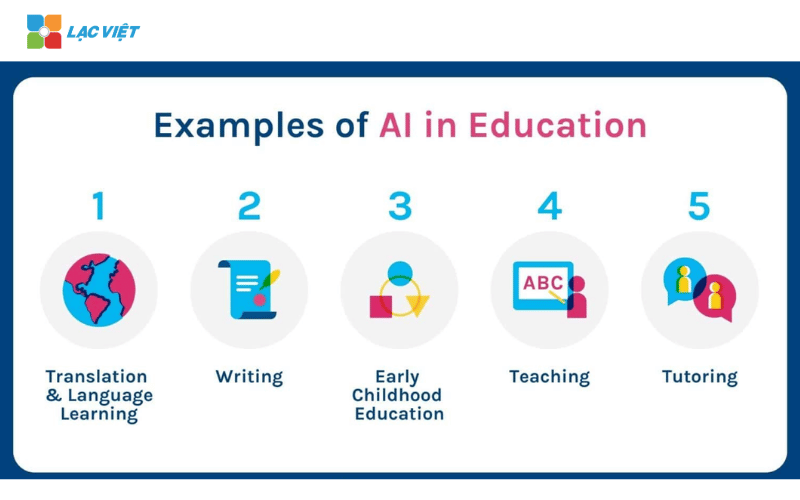
The figures below demonstrate markedly on the potential of AI in the education industry:
- According to the report from Research and Markets, market AI in education worldwide is expected to reach 20.8 b USD in 2027, with the growth rate dual (CAGR) is 45,12% from 2022 to 2027.
- A survey from EdTech Digest showed that 70% of the educational institutions have applied AI noted the significant improvement in academic results, operator.
- Research from McKinsey 2022 indicate that 85% of teachers feel AI help them optimize time and increase teaching effectiveness.
The data on the assertion that AI not only is the most trending fashion that is becoming important platform in the ecosystem global education.
- Application Lac Viet Chatbot AI consulting admissions efficiency, cost savings
- Lac Viet accompany UEH development virtual Assistant UEH AI Chatbot counseling, admissions, career guidance, and support learners
- 5 Main pillars of Digital Transformation in Higher Education
- Lac Viet introduction education platform application AI at the exhibition Smart City Asia 2025
2. The stage of development of ai in education
Stage 1: The beginning of ai in education (1950 – 1970s)
AI began to be studied from 1956 conference at Dartmouth, with the goal of building computer systems capable of thinking like humans. Scientists, including John McCarthy, Marvin Minsky, Allen Newell, has laid the foundation for artificial intelligence.
The first application in education
- The teaching system based on the computer appear in the 1960s, marking the first step of AI in education.
- PLATO (Programmed Logic for Automatic Teaching Operations) was developed by the University of Illinois, is one of the first system using a computer to support teaching.
Phase 2: tutoring system intelligent (its) (1970 – 1990s)
The advent of the tutoring system intelligent (Intelligent Tutoring Systems – ITS)
- ITS system is the computer program capable of tutoring students, using AI to simulate the role of the teacher.
- SCHOLAR (1970s) is one of the tutoring system first, to help students learn about geography.
The pattern AI enhanced learning experience
- 1980s: The system as SOPHIE, GUIDON, the Andes Physics Tutor help students learn subjects like physics, medicine.
- 1990s: AI began to be integrated into the platform of online education, creating a foundation for the development of e-learning.
Stage 3: ai-assisted online learning (2000 – 2010s)
The explosion of online education and MOOCS
- The development of the open online courses, the tea (MOOCs) such as Coursera, Udacity, edX was to promote application of AI in learning.
- AI are used to personalize content, track learning progress, evaluate competencies students.
Artificial intelligence support scoring and management education
- The scoring system automatically (Automated Essay Scoring – AES) such as PEG, e-rater began to appear, help reduce the load for teachers.
- AI is also used in management education, support, organization, classroom, evaluating the quality of teaching.
Stage 4: AI deep learning with educational personalization (2010 – present)
Machine Learning and Big Data advanced AIEd
- Technology, Machine Learning (ML), Processing natural language (NLP), computer vision (Computer Vision) to help AI understand, interact with students better.
- AI Chatbots support students, answer questions and help personalize the learning experience.
Personalize learning – education adaptation
- AI has the ability of data analysis, learning of each student, to propose appropriate content, improve learning outcomes.
- Knewton, Carnegie Learning is the foundation pioneer in the application of AI in education adaptive.
Artificial intelligence support capacity assessment students
- AI help create the quiz flexible, accurate measurement of the capacity of each student.
- Technology voice recognition student support pronunciation practice, improve language skills.
3. 7 Technology artificial intelligence AI is used in education, teaching
Here are the types of AI technology, popular be used in education:
3.1 Machine Learning (machine Learning)
Machine Learning is AI technology, allowing system to learn from data without the need for programming directly. In education, was used to analyze learning behavior and personalize the experience for each student.
Practical application: data analysis, learning to predict results; route Suggestions learning personalization based on the capacity and interests.
For example, DreamBox Learning using machine learning to create math exercises personalization for students.
3.2. Natural Language Processing (NLP – language Processing nature)
NLP is a technology that helps computers understand and process human language. In education, AI to help create the learning assistant tools, semantic analysis of text.
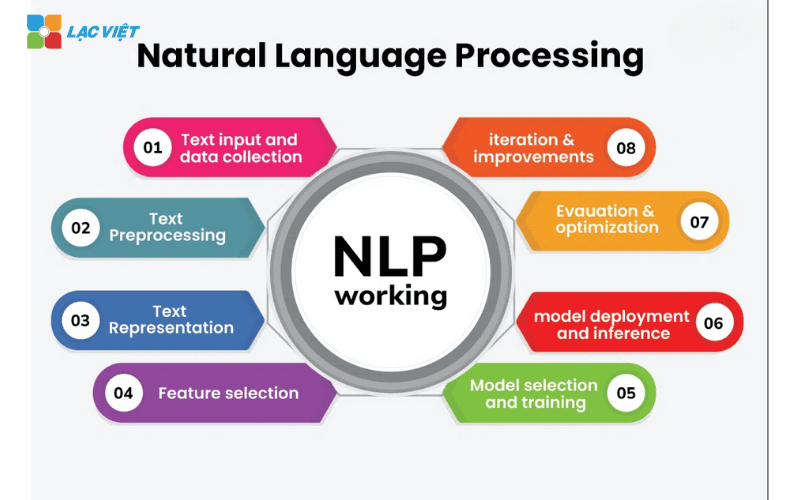
Practical application:
- Chatbot AI support students to answer questions and provide learning materials.
- Engine auto stop essay and semantic analysis academic writing.
- For example, Turnitin using NLP to analyze plagiarism and assess the quality of the article.
3.3. Computer Vision (computer vision)
Computer Vision is the technology that allows AI recognize and analyze images or videos. In education, computer vision is used to enhance the learning experience, monitor activity.
Practical application:
- Recognize facial expressions to assess the concentration level of students in online classes.
- Behavior analysis students through security cameras to ensure school safety.
For example: System Classroom Eye using computer vision to support teachers in classroom management.
3.4. Speech Recognition (voice Recognition)
Technology voice recognition lets AI convert speech to text or make voice commands.
Practical application:
- Support students language training, especially with speaking skills.
- Create virtual assistant academic voice.
For example, Duolingo uses voice recognition to help students improve pronunciation.
3.5. Robotics (technology, smart robots)
Robot integrators AI have the ability to interact with students, support teachers in teaching.
Practical application:
- Robot teaching, language or programming for children.
- Robot support students with disabilities in learning activities.
For example, the NAO Robot is used in many schools to teach language, social skills.
3.6. Virtual Reality (VR) and Augmented Reality (AR)
Technology VR/AR in combination with AI to create learning environment, virtual reality or augmented to help students better understand complex concepts.
Practical application:
- Create simulation science laboratory virtual.
- Provide the learning experience reality as visiting the historical places through VR.
For example: Google Expeditions use AR/VR to take students on virtual tours.

3.7. Recommender Systems (hint System)
This is the AI system analyzes the preferences and behavior of students to suggestions learning content accordingly.
Practical application:
- Suggestions the appropriate course based on personal preferences.
- Proposed assignments or course material added by the capacity of the student.
For example, Coursera use hint system to provide route optimal learning for users.
4. 4 apps artificial intelligence in education in Vietnam highlights current
4 apps artificial intelligence in education in Vietnam highlights current:
4.1 Application AI personalize the learning experience
Artificial intelligence in education to help education institutions experience design, learning separately, in accordance with the needs and abilities of each student, improving the efficiency comprehensive learning.
How AI done personalize learning
- Data analysis learning: AI track learning behavior, scores and preferences to provide content accordingly. For example: DreamBox uses AI to adjust the math homework based on a difficulty level that the student can handle. Knewton proposed new content based on the concepts that students have not yet mastered.
- Proposed route learning: AI design plan individual learning based on strengths, weaknesses, help students progress step by step.
- Instant feedback: AI put out the fast response, detailed exercises, hints documentation support helps students to improve in a timely manner.
Benefits of personalized learning
- Increase the learning effect: According to the study of Pearson Education, the application of personalized learning helps increase learning efficiency up to 40%.
- Maintain learning motivation: lessons in accordance with their interests and abilities to help students not feel boring, reduce the dropout rate.
- Improve confidence: students feel more confident when be learned according to the speed of his own.
4.2 AI virtual assistants and learning support smart
Virtual assistant application AI has become an effective tool to help students, teachers, increase academic performance, teaching.
Specific application of the learning assistant smart
- Learning assistant for students: Socratic by Google to answer questions exercises by image analysis and provides step details. ChatGPT support, answer questions, explain concepts, suggestions source material.
- Instructional support for teachers: AI search suggestions document in accordance with teaching content. Hint teaching methods based on data about effective classroom.
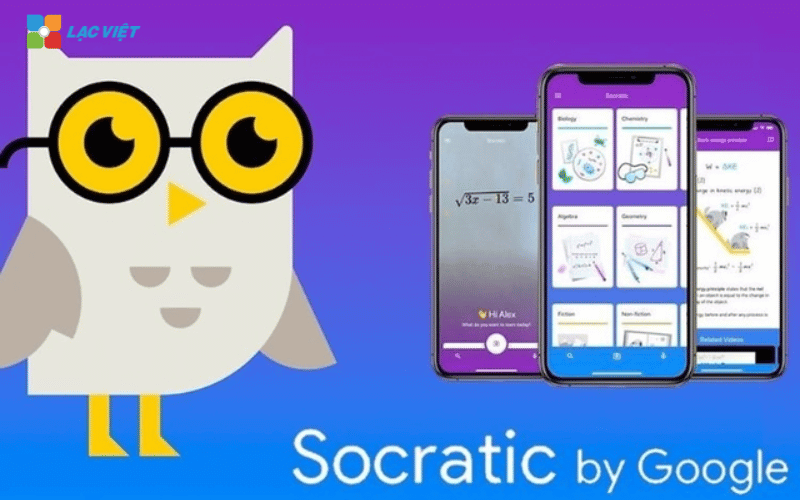
The actual impact
- Save time: According to EdTech Magazine, virtual assistants can handle 80% of the repeat questions, helping teachers to spend more time for creative work lectures.
- Increased satisfaction: students appreciate the AI assistant to receive feedback quickly and accurately, increasing the level of satisfaction by 30%.
- Support weaker students: AI can explain the concept in different ways, support students in difficulty.
4.3 Application AI analyze forecast data learning
Artificial intelligence in education not only support learning but also helps educational institutions, analysis and forecast data to make strategic decisions.
Way AI perform analysis and forecast
- Analysis of learning behavior: AI collect data from test completion time, the exercises, the level of interaction of the student to identify strengths and weaknesses. For example: Canvas LMS uses AI to analyze data learning, help teachers early detection of students at risk of weakness.
- Forecast learning outcomes: AI predicted score, or the ability to complete the course based on machine learning models (machine learning). System Early Warning Systems (EWS) warning potential issues as dropout rates, high or low points.
Benefit from the analysis and forecast
- Improve the quality of teaching: Teachers adjust teaching content based on detailed data.
- Increase the rate of completion of the course: According to a study by McKinsey, apply forecasting AI helps increase the rate of completion of the course up to 15%.
- Effective management of resources: Based on the forecast, the organization can allocate appropriate resources, such as increased support for the class that has the percentage of students tend to be higher.
4.4 Application AI strengthen the effectiveness education management
AI is changing the way educational institutions manage the operation, to help optimize processes, improve efficiency comprehensive.
App AI in education management
- Automation of administrative work: the AI System handles student records, scheduling and management fees automatically. For example: Ellucian solution provider AI help the university management optimization register for courses.
- Management facilities: AI predictions, schedule maintenance facilities based on the data used. Security monitoring in school by camera AI.
- Decision support: AI provides the report, comprehensive analysis to help leaders make the decision strategy. For example: AI predict the number of students enter the school in the entrance exam to the next.
The actual impact
- Reduce operating costs: According to reports from EdSurge, AI help reduce the cost of administration to 30%.
- Increased accuracy: process automation, AI reduce errors in data processing at under 5%.
- Enhance the learning experience: students and parents receive accurate information more quickly.
5. Artificial intelligence in education brings benefits?
5.1 enhance the accessibility of education for all subjects
Artificial intelligence in education help expand the accessibility of quality education for all students, regardless of geographic location, education level, or financial condition.
AI and education for students in rural and remote areas:
- The learning system, smart & virtual assistant can be deployed online to help students in rural or regional shortage of teachers approach is the lecture quality without resorting to traditional classes.
- AI eases the distinction about the quality of education, creating learning opportunities for all students, including those who are disadvantaged.
The data demonstrate:
- Report from UNESCO pointed out that more than 260 million children and adolescents around the world do not have chance to go to school. AI can be instrumental break help education to be with the children in these areas through the learning platform online.
- According to the World Economic Forum, AI can help reduce about 50% of the cost of education for students in the areas with difficult conditions, thereby creating opportunities for learning equality.

5.2 Improve the quality of teaching and effective learning
Artificial intelligence helps teachers and students to improve teaching effectiveness, learning through the tool support smart.
AI teacher support:
- Analysis students: AI can analyze the learning progress of each student, help teachers quickly realized the difficulties that students encounter and adjust the teaching methods accordingly.
- Teaching tools smart tools such as AI-driven teaching assistants can help teachers create these lectures, creative and unique, and helps students absorb easily, more excitement with the lesson.
- Automation of administrative tasks: help reduce the time spent on administrative tasks such as grading, reporting of results, helps teachers focus on teaching.
Impact on students:
- Students can learn with the roadmap, personalization receive instant feedback from the learning system, help improve the quality of learning.
- AI created the learning environment fun, flexible, reduce boredom, increase the capacity of the students.
Actual figures:
- According to research from the International Society for Technology in Education (ISTE), 85% of teachers said AI help them enhance effective teaching and help students to understand better.
- McKinsey & Company said the system learning support AI help strengthen the student's scores up 15% in key subject areas.

5.3 optimization educational management and reduce operating costs
Artificial intelligence AI not only helps to improve the quality of teaching but also optimize the management and operation of educational institutions. The application of AI in management, help reduce costs, improve the efficiency of administrative work.
Application AI in management, administrative and financial education:
- Automate the process of registration and tuition: AI helps automate the process of registering students, collect tuition, to send notifications through the system, saving time and effort of employees.
- Manage school calendar and allocate resources efficiently: AI can forecast demand teaching, allocate resources, teacher learning in an optimal way, reduce the shortage or surplus of teachers.
- Cost forecast and budget education: The AI system can predict operating costs of the educational institution, help with financial planning, accurate, cost savings.
Benefits for educational institutions:
- Reduce operating costs administrative up to 30% (as reported by Education Technology Group).
- Enhance the efficiency of resource use by 25% thanks to the optimization tool tuition, allocates resources automatically.
5.4 advanced professional skills and create employment opportunities for students
AI plays an important role in helping students develop professional skills in the learning environment, prepare for the future.
AI and learning professional skills:
- The online learning platform based on AI can offer courses from leading technology companies, helping students learn, develop skills such as programming, data analysis, AI.
- AI also helped create the simulation of practical learning, allowing students to experience work in industry before joining the labor market.
Data on employment opportunities:
- According to research by the World Economic Forum, the fields such as artificial intelligence, machine learning, blockchain technology needs are hiring high, create new career opportunities for students with knowledge about this technology.
- LinkedIn reported that work related to AI and data is growing at a rate of 40% per year, opens up great opportunities for students to be trained on this technology right from when I was in school.
6. Challenges and ways to overcome when the application AI in education
6.1 The problem of security and privacy
Artificial intelligence in education often require handling, storing large volumes of personal data of students, teachers and institutions. This raised concerns about security issues, privacy.
Concerns downloads: storing student data could be compromised or misused. The organization does not comply with security standards can attack the network, leading to leakage of sensitive information.
How to fix:
- Integrated security protocol as strong as encrypted data terminal, two-factor authentication.
- Compliance with international regulations on data privacy as GDPR or CCPA.
- Training employees to use AI system about the security measures necessary.
6.2 the Cost of the initial investment is high
App AI requires significant investment in infrastructure, technology, software, training, human resources. This can be a big barrier for many educational institutions, small or in the developing countries.
Solution:
- Start projects with small-scale test to evaluate the effectiveness, cost optimization.
- Call for collaboration with business and technology to get technical support, financial.
- Avail the solutions AI open source to reduce costs.
6.3 The availability of our team of teachers and students
Not all teachers are willing to use the tool AI due to lack of knowledge or technology skills.
Solution:
- Organize the training program skills to use tools AI for teachers and students.
- Simplify the interface design of the AI system user friendly.
- Create conditions for teachers and students to get acquainted with SOMEONE through the guided practice.
7. The development trend of artificial intelligence in education
Application extension AI in the field of education new
In the future, AI will not only limit in the support of teaching, but also expand into other areas such as:
- Career counseling automatically based on analysis of individual potential.
- Simulation and training virtual reality using AI technology to help students experience profession in real-world environments.
Cooperation between educational institutions and business technology
To maximize the potential of AI in education, the cooperation between educational institutions and business technology is very important.
For example:
- Google cooperated with many universities to develop the teaching tool ANYONE.
- Microsoft provides the platform for free for students to learn programming and engineering.
Set out ethical standards and management of AI in education
Application AI should go hand in hand with the construction of the policy, clear rules to ensure transparency, fairness in education.
Orientation:
- Building the legal framework for using AI in education.
- Ensure anyone AI works with the aim to support people, not to completely replace the teacher or created inequality in education.
Artificial intelligence is creating sweeping changes in the education industry, bringing great opportunities to improve the quality of teaching and learning, optimization, management, offers the learning opportunities more flexible for all students. Although there are still many challenges, but the potential that AI brings in improving the effectiveness of education, prepare for future generations is extremely pronounced.
Educational institutions and businesses can leverage AI to not only improve the quality of training but also contribute to the overall development of society in the digital era. Application artificial intelligence in education not only is the trend that is an essential requirement to continue to grow, bringing real value to generations of students, global education.
Do you know businesses are spending a lot of money to pay for staff looking for information?
- Of 1.8 hours per day employees spend out to search and collect information, the equivalent of 9.3 hours per week
- Business loss 500 hours per year for employees to perform searches for information for work
- 63% leadership said the sharing of knowledge and information internal trouble, reduce the productivity of the business
Lac Viet Chatbot AI assistant – Freeing up personnel to focus on creative work
- Virtual assistant process – approved LV Chatbot AI for Workflow: Access quick information, content summary, revise errors on file the signed
- Virtual assistant accountant LV Chatbot AI assistant for Finance: remove input crafts, bring the data to the correct input, automatically prompt-term LIABILITIES – PAYMENTS, cash flow forecasting, warning of financial risks
- Virtual assistant customer care LV CareBot AI assistant: Integrated Chat on multi-platform, feedback and customer requests quickly, consulting, flexible, not being constrained by fixed script
- Virtual assistant hr LV Chatbot AI for HXM: save 70% time for HR and leadership, extract the entire database of candidates any file format, faq auto welfare policies, rules, regulations 24/7, statistical, personnel, resources, business in few seconds.
CONTACT INFORMATION:
- Lac Viet Computing Corporation
- Hotline: 0901 555 063 | (+84.28) 3842 3333
- Email: info@lacviet.vn – Website: https://lacviet.vn
- Headquarters: 23 Nguyen Thi Huynh, P. 8, Q. Phu Nhuan, Ho Chi Minh city
Related questions
1. App AI in teaching what is?
AI in education to help personalize the learning experience, automation teaching advanced training effectiveness. Common applications include:
- System adaptive learning (Adaptive Learning): AI capacity analysis students, adjust the content to suit each individual.
- Virtual assistant & Chatbot education: Support, answer questions and provide documents, instructions, exercises in real time.
- Automatic marking – rated capacity: AI help scoring test, essay, test, assess language skills.
- Simulation & virtual reality in teaching: AI combined VR/AR help students reach knowledge more intuitive.
- System error detection, support learning: AI analysis work to point out mistakes, help to improve the skills of students.
2. What to do for the app WHO is in learning to be more efficient?
- Teacher training on AI: Provide knowledge and skills for teachers to use AI effectively in teaching.
- Integrated AI into the curriculum: design and content in accordance with AI technology to optimize the learning experience.
- Strengthen the interaction between AI and teachers: AI supports teaching, but teachers still need manual correction method is suitable.
- Guaranteed privacy & data security: strict Management of personal information of students when the application AI.
- Reviews effective use of AI: Measure the level of improvement in learning to optimize teaching methods.
3. Using AI technology in teaching
- App AI in design lecture: Using AI to create learning content personalization, matching the capacity of the student.
- Mining virtual assistant & Chatbot: Support students ' self-study, answer questions immediately.
- Leveraging AI in dot points: Integration of AI to put a quick post to provide detailed feedback to help students improve.
- Use of AI in data analysis learning: monitor the progress of learning, the proposed method improves the efficiency of learning.
- Applied AI technology on learning through virtual reality (VR) & simulation: Help students access to knowledge more lively in the sciences, history, techniques.

